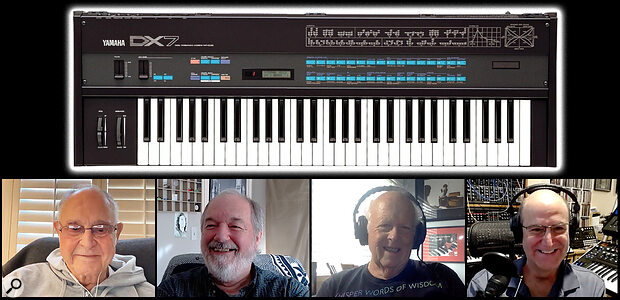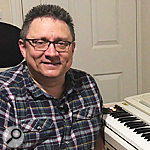 Yamaha DX7 team (l-r) - Dr John Chowning, Dave Bristow, Gary Leuenberger, Manny Fernandez
Yamaha DX7 team (l-r) - Dr John Chowning, Dave Bristow, Gary Leuenberger, Manny Fernandez
In May 1983, the world of synthesizers and electronic music as we knew it would change forever with the launch of the Yamaha DX7. To celebrate 40 years since its launch, Rob Puricelli spoke to Dr John Chowning, the developer of FM synthesis, Dave Bristow and Gary Leuenberger, sound designers for the original DX7, and Manny Fernandez, who has worked on all Yamaha’s FM projects from the MkII DX7 through to today’s Montage M series.
Show Notes
Chapters
00:00 - Introduction
01:55 - First Experiences Of The DX7
12:49 - Did The DX7 Meet Expectations?
16:57 - The Feedback Loop
17:51 - Creating And Sharing Sounds
22:47 - A Career From Creating Patches
27:55 - Sound Design Using FM
31:36 - Hearing Your Own Sounds
34:26 - Working With Don Lewis
44:26 - Demonstrating The DX7
57:00 - FM Synthesis 40 Years On
01:07:12 - Formant Shaping And The Future Of FM
Dr John Chowning - Biog
Born in Salem, New Jersey in 1934, John Chowning spent his school years in Wilmington, Delaware. Following military service and four years at Wittenberg University in Ohio, he studied composition in Paris with Nadia Boulanger. He received a doctorate in composition (DMA) from Stanford University in 1966, where he studied with Leland Smith.
 Chowning discovered the frequency modulation synthesis (FM) algorithm in 1967. This breakthrough in the synthesis of timbres allowed a very simple yet elegant way of creating and controlling time-varying spectra. In 1973 Stanford University licensed the FM synthesis patent to Yamaha in Japan, leading to the most successful synthesis engine in the history of electronic musical instruments.
Chowning discovered the frequency modulation synthesis (FM) algorithm in 1967. This breakthrough in the synthesis of timbres allowed a very simple yet elegant way of creating and controlling time-varying spectra. In 1973 Stanford University licensed the FM synthesis patent to Yamaha in Japan, leading to the most successful synthesis engine in the history of electronic musical instruments.
He taught computer sound synthesis and composition at Stanford University's Department of Music. In 1974, with John Grey, James (Andy) Moorer, Loren Rush and Leland Smith, he founded the Center for Computer Research in Music and Acoustics (CCRMA), which remains one of the leading centres for computer music and related research. Although he retired in 1996, he has remained in contact with CCRMA activities.
Chowning was elected to the American Academy of Arts and Sciences in 1988 and awarded the Honorary Doctor of Music by Wittenberg University in 1990. The French Ministre de la Culture awarded him the Diplôme d’Officier dans l’Ordre des Arts et Lettres in 1995. He was given the Doctorat Honoris Causa in 2002 by the Université de la Méditerranée, by Queen’s University in 2010, Hamburg University in 2016, and Laureate of the Giga-Hertz-Award in 2013.
Dave Bristow - Biog
Dave was born in London and worked as a professional keyboard player recording and touring internationally with a variety of artists including Polyphony, Slender Loris, June Tabor, Tallis and 2nd Vision. Active in synthesizer development, he played a central role in voicing the well-known Yamaha DX7 synthesizer and is internationally recognized as one of the important contributors to the development and voicing of FM synthesis, co-authoring a textbook on the subject with Dr John Chowning.
 Dave spent three years at IRCAM in Paris, running a MIDI and synthesis studio working with contemporary music composers and artists, then moved to the United States in the 1990s to work for Emu Systems, Inc. on sampling and filter-based synthesizers. In 2002, he began working again with Yamaha developing ringtones and system alert sounds for the SMAF audio chip series used in cell phones and mobile devices.
Dave spent three years at IRCAM in Paris, running a MIDI and synthesis studio working with contemporary music composers and artists, then moved to the United States in the 1990s to work for Emu Systems, Inc. on sampling and filter-based synthesizers. In 2002, he began working again with Yamaha developing ringtones and system alert sounds for the SMAF audio chip series used in cell phones and mobile devices.
He has been an instructor at Shoreline Community College teaching electronic music production and synthesis for 10 years, but still finds plenty of time for composing and playing piano with RedShift jazz quartet and developing his interest in computer arts.
Gary Leuenberger - Biog
Gary started in music at a young age and, in 1975, founded G. Leuenberger & Co. in San Francisco. It soon became one of the world’s largest retailers of pianos, synthesizers and electronic keyboards. In 1980 he started working with Yamaha as part of their product development team. It was through this that he was recruited, along with the likes of Dave Bristow and Don Lewis, to create the factory presets for the DX7.
 Gary’s most famous, or infamous, patch was the legendary 'E.Piano 1' which became equally one of the most popular and despised sounds ever! Nevertheless, his association with Yamaha continued until 2000, at which point Gary went back into education, gaining his Bachelors of Music and Masters in Classical Piano Performance from San Francisco State University in 2007.
Gary’s most famous, or infamous, patch was the legendary 'E.Piano 1' which became equally one of the most popular and despised sounds ever! Nevertheless, his association with Yamaha continued until 2000, at which point Gary went back into education, gaining his Bachelors of Music and Masters in Classical Piano Performance from San Francisco State University in 2007.
Since then, he has taught electronic music at SFSU and gives private tutoring to budding musicians of all ages.
Manny Fernandez - Biog
Dr Manny Fernandez has been involved in synthesizer programming and development with many manufacturers for over 35 years. Initially self-taught prior to traditional university study of analogue synthesis, in the late 1970s - early 1980s the emerging digital synthesis techniques caught his attention with their expanded timbral possibilities.
 He acquired a DX7 in the fall of 1983 and using Dr Chowning’s original academic articles as a guide, began exploring FM synthesis in depth. In 1987 he began his relationship with Yamaha, programming for a wide range of their synthesizers through the years to the current Montage M. Acknowledged as one of the world’s foremost FM synthesists and having extensive experience with physical modelling synthesis as well, his programming approach is to create unique and dynamic timbres with interesting yet useful real-time controller implementations.
He acquired a DX7 in the fall of 1983 and using Dr Chowning’s original academic articles as a guide, began exploring FM synthesis in depth. In 1987 he began his relationship with Yamaha, programming for a wide range of their synthesizers through the years to the current Montage M. Acknowledged as one of the world’s foremost FM synthesists and having extensive experience with physical modelling synthesis as well, his programming approach is to create unique and dynamic timbres with interesting yet useful real-time controller implementations.
Interviewer: Rob Puricelli - Biog
 Rob Puricelli is a Music Technology journalist and podcaster who has a healthy obsession with classic synthesizers and their history. In between restoring Fairlights and other vintage synths, he also writes reviews and articles for music tech publications, as well as hosting a weekly livestream on YouTube for the Pro Synth Network. He works alongside a number of manufacturers, demonstrating their products and lecturing at various educational and vocational establishments about music technology.
Rob Puricelli is a Music Technology journalist and podcaster who has a healthy obsession with classic synthesizers and their history. In between restoring Fairlights and other vintage synths, he also writes reviews and articles for music tech publications, as well as hosting a weekly livestream on YouTube for the Pro Synth Network. He works alongside a number of manufacturers, demonstrating their products and lecturing at various educational and vocational establishments about music technology.
Twitter: @failedmuso
Instagram: @failedmuso
Facebook: https://www.facebook.com/failedmuso/
About the Electronic Music podcast channel
On this channel we feature some of the pioneers of the industry, interview musicians, and talk about retro and current gear.
Available on Apple Podcasts, Google Podcasts, Spotify, Amazon or wherever you get your podcasts.

